Terror, resistance and trauma in Papua (Indonesia) - PapuaWeb
Terror, resistance and trauma in Papua (Indonesia) - PapuaWeb
Terror, resistance and trauma in Papua (Indonesia) - PapuaWeb
- No tags were found...
Create successful ePaper yourself
Turn your PDF publications into a flip-book with our unique Google optimized e-Paper software.
Centre for International Governance <strong>and</strong> Justice<br />
<strong>Terror</strong>, <strong>resistance</strong> <strong>and</strong> <strong>trauma</strong> <strong>in</strong> <strong>Papua</strong> (<strong>Indonesia</strong>)<br />
Budi J. Hernawan<br />
Issues Paper 14<br />
December 2009
<strong>Terror</strong>, <strong>resistance</strong> <strong>and</strong> <strong>trauma</strong> <strong>in</strong> <strong>Papua</strong> (<strong>Indonesia</strong>)<br />
Budi J. Hernawan<br />
CENTRE FOR INTERNATIONAL GOVERNANCE<br />
AND JUSTICE ISSUES PAPER NO. 14<br />
December 2009
© Centre for International Governance <strong>and</strong> Justice, Regulatory Institutions Network,<br />
Australian National University 2009<br />
National Library of Australia Catalogu<strong>in</strong>g-<strong>in</strong>-Publication entry<br />
Hernawan, Budi J.<br />
<strong>Terror</strong>, <strong>resistance</strong> <strong>and</strong> <strong>trauma</strong> <strong>in</strong> <strong>Papua</strong> (<strong>Indonesia</strong>)<br />
9780980683752<br />
Issues paper (Australian National University. Centre for<br />
International Governance <strong>and</strong> Justice) ; 14<br />
Social conflict--<strong>Papua</strong> (<strong>Indonesia</strong>).<br />
Social movements--<strong>Papua</strong> (<strong>Indonesia</strong>).<br />
Political violence--<strong>Papua</strong> (<strong>Indonesia</strong>).<br />
<strong>Terror</strong>ism--<strong>Papua</strong> (<strong>Indonesia</strong>).<br />
<strong>Papua</strong> (<strong>Indonesia</strong>)--Autonomy <strong>and</strong> <strong>in</strong>dependence movements.<br />
<strong>Papua</strong> (<strong>Indonesia</strong>)--Politics <strong>and</strong> government.<br />
<strong>Papua</strong> (<strong>Indonesia</strong>)--Social conditions.<br />
Australian National University. Centre for International<br />
Governance <strong>and</strong> Justice.<br />
320.90951
<strong>Terror</strong>, Resistance <strong>and</strong> Trauma <strong>in</strong> <strong>Papua</strong> (<strong>Indonesia</strong>)<br />
By Budi Hernawan OFM ∗<br />
<strong>Papua</strong> recently attracted the attention of the <strong>in</strong>ternational community, <strong>and</strong> <strong>in</strong> particular of Australia,<br />
when Australian citizen Drew Grant was killed <strong>in</strong> a shoot<strong>in</strong>g <strong>in</strong>cident <strong>in</strong> the early morn<strong>in</strong>g of 11<br />
July 2009 <strong>in</strong> the Freeport M<strong>in</strong><strong>in</strong>g area <strong>in</strong> Tembagapura, <strong>Papua</strong> (The Jakarta Globe, 13 July 2009).<br />
This kill<strong>in</strong>g ignited a series of violent acts <strong>in</strong> the world largest gold <strong>and</strong> copper m<strong>in</strong>e site. Police are<br />
yet to provide an explanation of the <strong>in</strong>cident. The shoot<strong>in</strong>g immediately sparked speculation <strong>in</strong> the<br />
public <strong>and</strong> <strong>in</strong>ternational media forc<strong>in</strong>g a highly-ranked representative of the <strong>Indonesia</strong>n<br />
Government to provide a public statement. On 16 July the M<strong>in</strong>ister of Defence, Yuwono<br />
Sudarsono, claimed that a ‘rogue element’ <strong>in</strong> the military might have been <strong>in</strong>volved <strong>in</strong> the shoot<strong>in</strong>g<br />
(ABC News, 16 July 2009).<br />
Despite the lack of strong evidence, the police arrested <strong>and</strong> deta<strong>in</strong>ed 9 civilians on 20 July 2009 <strong>and</strong><br />
charged them with murder, even though the unidentified gunmen cont<strong>in</strong>ued to engage <strong>in</strong> acts of<br />
shoot<strong>in</strong>g (The Jakarta Post, 12/8/09). This story sounds familiar for many <strong>Papua</strong>ns, recall<strong>in</strong>g<br />
memories of a similar <strong>in</strong>cident <strong>in</strong> August 2002, when one <strong>Indonesia</strong>n <strong>and</strong> two American teachers<br />
were shot dead <strong>in</strong> an ambush at the Freeport M<strong>in</strong><strong>in</strong>g site.<br />
Such an <strong>in</strong>cident might represent the spectre of terror that marks the l<strong>and</strong>scape of Freeport m<strong>in</strong><strong>in</strong>g<br />
area (Ballard 2002) <strong>and</strong> has shaped memoria passionis of the <strong>Papua</strong>ns as a whole. As a response to<br />
the repeated terror, the <strong>Papua</strong>ns expressed their opposition to be cont<strong>in</strong>uously blamed as a<br />
scapegoat. In a rarely issued public statement dated 15 July 2009, Kelly Kwalik, the leader of the<br />
Organisasi Pembebasan Papoea Merdeka (OPM) <strong>in</strong> the Timika area, expressed his strong denial<br />
that he or his group was <strong>in</strong>volved <strong>in</strong> the attack <strong>in</strong> any way (Kwalik 2009). This act illustrates the<br />
<strong>resistance</strong> aspect <strong>in</strong> <strong>Papua</strong> that responds to prolonged oppressive mechanisms that sacrifice<br />
<strong>Papua</strong>ns. Over time, terror <strong>and</strong> <strong>resistance</strong> have become a dialectic that leaves the <strong>Papua</strong>ns<br />
<strong>trauma</strong>tised <strong>and</strong> forms an unbreakable cycle. This current pattern of terror needs to be understood<br />
with<strong>in</strong> <strong>Papua</strong>’s broader historical context <strong>and</strong> the legacy of the region’s early history.<br />
This paper does not <strong>in</strong>tend to provide an <strong>in</strong>-depth exam<strong>in</strong>ation of <strong>Papua</strong>’s history. Rather, it aims to<br />
reflect on the prolonged terror, <strong>resistance</strong> movements <strong>and</strong> <strong>trauma</strong> that have characterised <strong>Papua</strong> to<br />
date. Yet <strong>in</strong> order to do so, we need to trace the historical context, <strong>in</strong>clud<strong>in</strong>g <strong>in</strong> particular the<br />
transfer of this area to <strong>Indonesia</strong>n adm<strong>in</strong>istration on 1 May 1963 by the United Nations Temporary<br />
Executive Authority (UNTEA), under Article XII of the 1962 New York Agreement.<br />
The paper beg<strong>in</strong>s by summaris<strong>in</strong>g the key arguments that scholars suggested underp<strong>in</strong>ned the power<br />
struggle between <strong>Indonesia</strong> <strong>and</strong> the Netherl<strong>and</strong>s. Secondly, it discusses the establishment of control<br />
mechanisms that have resulted <strong>in</strong> a dialectic of terror <strong>and</strong> <strong>resistance</strong>. Thirdly, it briefly explores<br />
<strong>trauma</strong> as an impact of the dialectic of terror <strong>and</strong> <strong>resistance</strong>.<br />
I. The Power Struggle of the 1960s<br />
Many publications have been written, from various perspectives, on the power struggle between the<br />
Netherl<strong>and</strong>s <strong>and</strong> <strong>Indonesia</strong> over control <strong>and</strong> access to West New Gu<strong>in</strong>ea (WNG). All authors agree<br />
that the Cold War played a decisive role <strong>in</strong> direct<strong>in</strong>g the political negotiations between the<br />
∗ PhD C<strong>and</strong>idate at the Regulatory Institutions Network, Australian National University. The author is a Franciscan friar<br />
who previously worked for ten years at the Office for Justice <strong>and</strong> Peace of the Catholic Church <strong>in</strong> Jayapura, West<br />
<strong>Papua</strong>, <strong>Indonesia</strong>. An earlier version of this paper was presented on 21 August 2009 at a Public Forum held at the<br />
University of Sydney <strong>and</strong> organised by <strong>Indonesia</strong>n Solidarity <strong>and</strong> the Centre for Peace <strong>and</strong> Conflict Studies of the<br />
University of Sydney.<br />
1
Netherl<strong>and</strong>s <strong>and</strong> <strong>Indonesia</strong> towards a situation that supported the <strong>Indonesia</strong>n claim over West New<br />
Gu<strong>in</strong>ea (Saltford 2003; Drooglever 2008; Vlasblom 2004; Tjondronegoro 1977). S<strong>in</strong>ce the 1949<br />
Round Table Conference (RTC), both <strong>Indonesia</strong> <strong>and</strong> the Netherl<strong>and</strong>s acknowledged that they could<br />
not resolve their disagreement <strong>in</strong> regard to WNG.<br />
<strong>Indonesia</strong>, which preferred to call WNG “West Irian” (WI), argued that WI had been part of the<br />
Netherl<strong>and</strong>s colonial possessions. So under the transfer of sovereignty as agreed dur<strong>in</strong>g the RTC,<br />
West Irian had to be h<strong>and</strong>ed over to <strong>Indonesia</strong> (Yam<strong>in</strong> 1965; Lâm 2000). Moreover, the <strong>Indonesia</strong>n<br />
found<strong>in</strong>g fathers extended their argument to the era of Majapahit <strong>and</strong> Sriwijaya K<strong>in</strong>gdoms, when<br />
WI had been part of their territory (Yam<strong>in</strong> 1956; Tjondronegoro 1977). Therefore, Soekarno<br />
strongly rejected the Dutch argument on self-determ<strong>in</strong>ation for the <strong>Papua</strong>ns at the front of the<br />
<strong>in</strong>ternational media <strong>in</strong> Tokyo on 20 September 1961 by argu<strong>in</strong>g:<br />
I know also what such a policy of ‘self-determ<strong>in</strong>ation’ under foreign supervision can br<strong>in</strong>g<br />
about. The application of such a policy is not new for us. In Van Mook’s time such a policy<br />
of so called ‘self-determ<strong>in</strong>ation’ resulted <strong>in</strong> the formation of a ‘Free East Sumatra’, a ‘Free<br />
South Sumatra’, a ‘Free Pasundan’ (West Java), a ‘Free East <strong>Indonesia</strong>’, <strong>and</strong> other so called<br />
autonomous territories. In do<strong>in</strong>g so, Van Mook actually balkanised <strong>Indonesia</strong>....I reject this<br />
so called ‘self-determ<strong>in</strong>ation’ policy of the Dutch Government. This policy leads only to<br />
trouble <strong>in</strong> the future. (Departemen Penerangan RI 1962:93).<br />
This l<strong>in</strong>e of argument has been embedded <strong>in</strong> the m<strong>in</strong>dset of the <strong>Indonesia</strong>n authority ever s<strong>in</strong>ce <strong>and</strong><br />
it is repeatedly expressed <strong>in</strong> official government documents (Tjondronegoro 1977; Permanent<br />
Mission of the Republic of <strong>Indonesia</strong> to the UN 2003).<br />
The Netherl<strong>and</strong>s, on the other h<strong>and</strong>, argued that the territory of New Gu<strong>in</strong>ea was excluded from the<br />
transfer of sovereignty on two grounds:<br />
[1] <strong>in</strong> view of the marked ethnological, cultural <strong>and</strong> religious differences between<br />
<strong>Indonesia</strong>ns <strong>and</strong> <strong>Papua</strong>ns <strong>and</strong> [2] because the <strong>Papua</strong>n population had not been <strong>in</strong> a position<br />
to express themselves freely on their political status. The proclamation of <strong>Indonesia</strong><br />
<strong>in</strong>dependence of 17 August 1945 could <strong>in</strong> no way constitute an expression of will by the<br />
<strong>Papua</strong>n people as there was, because of wartime circumstances, no means of communication<br />
with New Gu<strong>in</strong>ea. (Memor<strong>and</strong>um 1961).<br />
These two positions were <strong>in</strong>herently at odds with each other, but due to the <strong>in</strong>fluence of the US<br />
(Saltford 2003:12; Drooglever 2008; Lâm 2000:120), the Netherl<strong>and</strong>s signed the 1962 New York<br />
agreement <strong>and</strong> h<strong>and</strong>ed over the territory to UNTEA. Six weeks later it transferred the territory to<br />
the <strong>Indonesia</strong>n authorities.<br />
Therefore, it is not a surprise that <strong>Indonesia</strong> immediately <strong>in</strong>stalled any key <strong>in</strong>stitution that embodied<br />
its philosophy of sovereignty, <strong>in</strong>clud<strong>in</strong>g, but not limited to, the Territorial Comm<strong>and</strong>er of the<br />
military on 17 May 1963 (D<strong>in</strong>as Penerangan Kodam XVII/ Tjenderawasih 1971:102), the<br />
University of Cenderawasih <strong>in</strong> 1965, <strong>and</strong> the agreement with Freeport McMoran <strong>in</strong> 1967 (Vlasblom<br />
2004) that represented power, knowledge <strong>and</strong> economy, respectively. Even the first <strong>in</strong>filtration<br />
group, Pasukan Gerilja 100, consist<strong>in</strong>g of 29 personnel, was sent from Buru Isl<strong>and</strong> <strong>in</strong> Molluccas to<br />
Etna Bay <strong>in</strong> <strong>Papua</strong> on 30 November 1960 (Cholil 1971:57). It was very obvious that the issue of<br />
WNG was not merely rhetoric but it was a matter of sovereignty of a newly emerg<strong>in</strong>g nation-state<br />
vis-à-vis a colonial power. It was these early contests over WNG which significantly constituted the<br />
nature of the <strong>Indonesia</strong>n state.<br />
2
II.<br />
The Dialectic of <strong>Terror</strong> <strong>and</strong> Resistance<br />
While the transition of power was under way, the <strong>Indonesia</strong>n adm<strong>in</strong>istration took all necessary<br />
measures, <strong>in</strong>clud<strong>in</strong>g coercive measures, to ensure that the result of the UN supervised plebiscite was<br />
<strong>in</strong> favour of <strong>Indonesia</strong>. Patchy records of the 1963-1969 history reported at least n<strong>in</strong>e cases of<br />
torture as a result of the implementation of coercive measures to oppress dissidents oppos<strong>in</strong>g<br />
<strong>Indonesia</strong> (Vlasblom 2004). Often these dissidents were pursu<strong>in</strong>g the right to self-determ<strong>in</strong>ation<br />
guaranteed by the 1962 New York Agreement. For example, the Mee people <strong>in</strong> the Paniai region<br />
expressed their strong opposition to the <strong>Indonesia</strong>n presence by attack<strong>in</strong>g the military post <strong>and</strong> the<br />
government offices <strong>in</strong> Enarotali, the district capital. The <strong>in</strong>cident began <strong>in</strong> February 1969 <strong>and</strong><br />
cont<strong>in</strong>ued until August 1969 (Giay 1993; Djopari 1993; Vlasblom 2004).<br />
The ongo<strong>in</strong>g resentment eventually culm<strong>in</strong>ated <strong>in</strong> the creation of a movement called Organisasi<br />
Pembebasan Papoea Merdeka (OPM) (Vlasbloom 2004; Djopari 1993). OPM was established <strong>in</strong><br />
1964 <strong>in</strong> Manokwari as the most outst<strong>and</strong><strong>in</strong>g reaction to the presence of the <strong>Indonesia</strong>n authorities.<br />
Once the so-called “Act of Free Choice” unanimously agreed that <strong>Papua</strong> would be <strong>in</strong>tegrated <strong>in</strong>to<br />
<strong>Indonesia</strong>, General Soeharto, who had recently <strong>in</strong>stalled Orde Baru (the New Order), strengthened<br />
<strong>Indonesia</strong>n control over the territory through an extensive <strong>and</strong> centralised military comm<strong>and</strong>. At the<br />
same time, OPM had <strong>in</strong>augurated its first battle aga<strong>in</strong>st the <strong>Indonesia</strong>n authority. Its guerilla war<br />
resulted <strong>in</strong> 17 major attacks on the military <strong>and</strong> police <strong>in</strong>stallations across <strong>Papua</strong> dur<strong>in</strong>g 1964-1977<br />
(Djopari 1993: 109; Vlasblom 2004).<br />
For the <strong>Papua</strong>ns, OPM symbolises <strong>resistance</strong> aga<strong>in</strong>st the terror that has tried to control the <strong>Papua</strong>ns<br />
through fear-controlled mechanisms. Under the New Order regime, Soeharto deployed a highly<br />
centralised military comm<strong>and</strong> to eradicate communism <strong>in</strong> 1965 (Roosa 2008:38). As a<br />
consequence, the <strong>Indonesia</strong>n authority exercised its power through its military comm<strong>and</strong>s across<br />
<strong>Papua</strong>, from the village level (Bab<strong>in</strong>sa) up to the prov<strong>in</strong>cial level even before WNG was officially<br />
<strong>in</strong>tegrated <strong>in</strong>to <strong>Indonesia</strong>. The top <strong>and</strong> key positions of the local governments were occupied by topranked<br />
military officers <strong>and</strong> various special military operations were launched to eradicate the<br />
separatist groups of OPM, <strong>in</strong>clud<strong>in</strong>g Operasi Sadar (1965-1967), Operasi Bharatayuda (1967-1969),<br />
Operasi Wibawa (1969), Operasi Jayawijaya (1977), Operasi Sapu Bersih I <strong>and</strong> II (1981) <strong>and</strong> the<br />
status of Daerah Operasi Militer (DOM/ Military Operation Zone) dur<strong>in</strong>g 1980s until 1998.<br />
Hav<strong>in</strong>g combated the communist threat through the use of torture (Roosa 2008:34), the Orde Baru<br />
regime <strong>in</strong>troduced a similar method to <strong>Papua</strong>. Accord<strong>in</strong>g to the cases that I have collected on torture<br />
<strong>in</strong> <strong>Papua</strong> s<strong>in</strong>ce 1963, 393 <strong>in</strong>dividual cases of torture across <strong>Papua</strong> have been documented, not<strong>in</strong>g the<br />
identity of victims <strong>and</strong> a factual description. A further 14 cases require further documentation. My<br />
prelim<strong>in</strong>ary research shows that most of the victims are farmers, males <strong>and</strong> highl<strong>and</strong>ers who live <strong>in</strong><br />
the rural areas. Only two cases <strong>in</strong>volve victims who were OPM members, with none be<strong>in</strong>g an OPM<br />
leader. All female victims were sexually abused, raped or sexually enslaved. Some victims were<br />
deta<strong>in</strong>ed for a short period of time, but most victims were never charged nor brought before a court.<br />
On the side of perpetrators, the 2000 Abepura case of torture is the only case where the perpetrators<br />
(two police officers) were brought to the human rights court <strong>and</strong> eventually acquitted. Therefore,<br />
the perpetrators have enjoyed complete impunity.<br />
Another dist<strong>in</strong>ctive characteristic that might differentiate the <strong>Papua</strong> torture from the 1965 situations<br />
<strong>in</strong> Aceh <strong>and</strong> Timor Leste is that no report shows any particular places designated for a torture<br />
chamber. Most cases were deliberately committed <strong>in</strong> front of a public audience, whilst some<br />
occurred <strong>in</strong> ord<strong>in</strong>ary military <strong>and</strong> police posts.<br />
Given that most victims were never charged or sentenced, <strong>and</strong> many were tortured <strong>in</strong> public, I<br />
would argue that torture <strong>in</strong> <strong>Papua</strong> does not aim at extract<strong>in</strong>g real <strong>in</strong>formation on OPM. Instead,<br />
3
torture represents a larger mach<strong>in</strong>ery that aims to control the whole community by conjur<strong>in</strong>g <strong>and</strong><br />
ma<strong>in</strong>ta<strong>in</strong><strong>in</strong>g the spectre of terror. The survivors of torture rema<strong>in</strong> liv<strong>in</strong>g <strong>in</strong> their own families <strong>and</strong><br />
communities <strong>and</strong> thus share their stories with them. By tell<strong>in</strong>g their stories, the survivors<br />
<strong>in</strong>advertently transfer <strong>and</strong> reproduce the mark of terror <strong>in</strong>to the community <strong>and</strong> thus re<strong>in</strong>force its<br />
impact on their lives. The authorities might assume that such practice will deter the whole<br />
community from jo<strong>in</strong><strong>in</strong>g the <strong>resistance</strong> movements <strong>and</strong> eventually eradicate the OPM itself.<br />
By deploy<strong>in</strong>g torture, the authority uses kill<strong>in</strong>gs as the last resort s<strong>in</strong>ce the corpses would not be<br />
able to pass on any stories to the daily life. With<strong>in</strong> the Melanesian cultural context that is highly<br />
marked by reciprocity <strong>and</strong> retribution when it comes to any communal dispute. Any unpunished <strong>and</strong><br />
uncompensated crime like torture has become unbearable not only for the survivors but also for the<br />
whole community because it destroys the harmony with<strong>in</strong> the community that ma<strong>in</strong>ta<strong>in</strong>s the public<br />
order (Harrison 1993). Moreover, victims have to face the harsh reality that none of the perpetrators<br />
acknowledge their deeds even before the court.<br />
In fact, the <strong>resistance</strong> movement cont<strong>in</strong>ues to grow. Its political element was transformed <strong>in</strong>to a<br />
political body of Presidium Dewan <strong>Papua</strong> (PDP/ <strong>Papua</strong>n Presidium Council) dur<strong>in</strong>g the Second<br />
<strong>Papua</strong>n Congress <strong>in</strong> 2000. This resilient development <strong>and</strong> transformation might signify the<br />
adaptability of this movement to respond to the terror strategy. Follow<strong>in</strong>g the 2000 Congress, PDP<br />
has embarked on its political campaign based on the two key arguments similar to the ones<br />
proposed by the Dutch <strong>in</strong> 1960s, that is the cultural <strong>and</strong> ethnic (the religious element is excluded)<br />
dist<strong>in</strong>ctiveness <strong>and</strong> the right to self-determ<strong>in</strong>ation dur<strong>in</strong>g the 1969 plebiscite.<br />
While the military cont<strong>in</strong>ues its mission to eradicate OPM, the <strong>Indonesia</strong>n authorities seem<strong>in</strong>gly are<br />
not prepared to engage <strong>in</strong> any discourse related to these two key arguments. This attitude has lead to<br />
a deadlock <strong>and</strong> the absence of positive means <strong>in</strong> the last 46 years (Braithwaite 2008) which was<br />
marked by the declaration of the <strong>Papua</strong>n Presidium Council on 1 December 2008 that declared<br />
<strong>Papua</strong> as an emergency zone (<strong>Papua</strong> Zona Darurat) <strong>and</strong> sent an urgent appeal to the <strong>in</strong>ternational<br />
community to act upon the endangered <strong>in</strong>digenous <strong>Papua</strong>ns.<br />
III.<br />
The Impact of Trauma<br />
The third key element of this Paper is the impact of the dialectic of terror <strong>and</strong> <strong>resistance</strong> on the<br />
people. Little research has been done <strong>in</strong> this area compared to the large amount of research on the<br />
historical <strong>and</strong> legal aspects of the <strong>Papua</strong>n dispute. The voices of the torture survivors <strong>in</strong> <strong>Papua</strong> are<br />
represented by the local Civil Society Organisations (CSOs) that documented their narratives <strong>and</strong><br />
brought them to any legal channel available. Only the 1995 Timika case was jo<strong>in</strong>tly exposed by<br />
both Bishop Herman Mün<strong>in</strong>gghoff OFM <strong>and</strong> the Australian Council For Overseas Aid (ACFOA).<br />
Aside from the restriction to the foreign human rights organisations <strong>and</strong> journalists, this fact shows<br />
that the local is the real partner for the survivors.<br />
From the available documentation on torture <strong>in</strong> <strong>Papua</strong>, a big gap is the account of <strong>trauma</strong> on the<br />
survivors <strong>and</strong> the community. The major study on politically motivated torture <strong>and</strong> the heal<strong>in</strong>g of<br />
the torture survivors <strong>in</strong> Southeast Asia shows that:<br />
[T]rauma experience <strong>and</strong> exposure for more than three <strong>trauma</strong> events negatively predicted<br />
mental health <strong>trauma</strong>. Mental illness was associated with impaired physical function <strong>and</strong><br />
high dem<strong>and</strong> for health services. Risk of mental illness fell across time. (Quiroga <strong>and</strong><br />
Jaranson 2005:14).<br />
S<strong>in</strong>ce the <strong>Papua</strong>n torture survivors were exposed to repeated <strong>trauma</strong> experience, it can be assumed<br />
that those people suffer from mental health <strong>trauma</strong> that might impair their physical function.<br />
4
“Traumatic events are extraord<strong>in</strong>ary, not because they occur rarely, but rather because they<br />
overwhelm the ord<strong>in</strong>ary human adaptations to life” (Herman 1992:33). This situation might be<br />
exacerbated by the poor health facilities <strong>in</strong> the rural areas where most torture survivors reside,<br />
mean<strong>in</strong>g they might not have been given proper treatment for their <strong>in</strong>jury.<br />
One of the <strong>Papua</strong>n political refugees <strong>in</strong> Australia acknowledged that the impact of electric shock<br />
dur<strong>in</strong>g the <strong>in</strong>terrogation at the military custody <strong>in</strong> <strong>Papua</strong> <strong>and</strong> the prolonged solitary conf<strong>in</strong>ement <strong>in</strong> a<br />
prison have caused arthritis <strong>and</strong> sp<strong>in</strong>al cord problems years after the actual torture. Fortunately, this<br />
person receives proper medical treatment <strong>in</strong> Australia that susta<strong>in</strong>s this person’s life.<br />
Judith Herman summarised the impact of post-<strong>trauma</strong>tic stress disorder (PTSD) of the torture<br />
survivors <strong>in</strong>to three major categories: ‘hyperarousal’, which causes a permanent self-alarm<strong>in</strong>g<br />
mechanism; ‘<strong>in</strong>trusion’, which blocks the memory from function<strong>in</strong>g normally; <strong>and</strong> ‘constriction’,<br />
which causes numbness that shuts down the self-defence system (Herman 1992). These symptoms<br />
lead to disempowerment <strong>and</strong> disconnection with others. At the societal level, “<strong>trauma</strong> challenges<br />
five core adaptive systems: safety, attachment, justice, identity role, <strong>and</strong> existential mean<strong>in</strong>g”<br />
(Quiroga <strong>and</strong> Jaranson 2005:27) because the mean<strong>in</strong>g of the world is destroyed (Scary 1985).<br />
However, the more important issue we need to address is heal<strong>in</strong>g. Judith Herman argues that a<br />
heal<strong>in</strong>g relationship comes first before everyth<strong>in</strong>g else to rega<strong>in</strong> the control of self which has been<br />
paralysed by repeated <strong>trauma</strong>. In the case of <strong>Papua</strong>, on the one h<strong>and</strong>, the oral tradition that enables a<br />
community member to share his or her experience with other members might help the <strong>Papua</strong>ns to<br />
mitigate the impact of <strong>trauma</strong> on themselves <strong>and</strong> their community. On the other h<strong>and</strong>, however, no<br />
professional help is provided, so any PTSD symptom requir<strong>in</strong>g professional assistance has not been<br />
treated properly. If such a th<strong>in</strong>g cont<strong>in</strong>ues to accumulate over more than four decades, one can<br />
assume that the whole community might have suffered from prolonged complex PTSD <strong>and</strong> has<br />
been impaired from develop<strong>in</strong>g to its full capacity.<br />
The absence of a <strong>trauma</strong> heal<strong>in</strong>g centre might <strong>in</strong>dicate that <strong>trauma</strong> rema<strong>in</strong>s denied or at least<br />
unrecognised by the authorities <strong>and</strong> the whole nation. The silence of the nation over the atrocities of<br />
1965 <strong>in</strong> Aceh <strong>and</strong> Timor Leste also applies to the case of <strong>Papua</strong>, leav<strong>in</strong>g the survivors <strong>in</strong> isolation.<br />
Such silence is only beneficial to the perpetrators.<br />
At the societal level, <strong>in</strong> the last ten years a number of peace <strong>in</strong>itiatives have been promoted by<br />
CSOs, ma<strong>in</strong>ly by <strong>Papua</strong>n religious leaders. They have pursued peace by work<strong>in</strong>g at the <strong>in</strong>ter-faith<br />
level to end violence, <strong>in</strong>clud<strong>in</strong>g torture, under various banners, such as FORERI, <strong>Papua</strong> Baru (New<br />
<strong>Papua</strong>), <strong>Papua</strong> Zona Damai (<strong>Papua</strong> Zone of Peace), <strong>and</strong> <strong>Papua</strong> Tanah Damai (<strong>Papua</strong> L<strong>and</strong> of<br />
Peace). Even though the central government <strong>and</strong> the military have not yet shown <strong>in</strong>terest <strong>in</strong> any of<br />
these <strong>in</strong>itiatives, the local government, the police <strong>and</strong> the prov<strong>in</strong>cial council have participated <strong>in</strong><br />
related activities. Such a movement might help to develop the type of heal<strong>in</strong>g relationship that is<br />
fundamental to <strong>trauma</strong> heal<strong>in</strong>g <strong>in</strong> <strong>Papua</strong>. However, much work needs to be done <strong>in</strong> the area of<br />
develop<strong>in</strong>g a conceptual framework that could adequately address the complex situation of<br />
<strong>trauma</strong>tised <strong>Papua</strong>ns <strong>and</strong> that could resonate at the highest level of the <strong>Indonesia</strong>n authority. This<br />
deadlock situation has prompted the <strong>Indonesia</strong>n Government Research Institute (LIPI) to propose a<br />
conceptual framework for a peaceful solution entitled <strong>Papua</strong> Road Map (Widjojo 2009), even<br />
though the key players <strong>in</strong> Jakarta exhibit little <strong>in</strong>terest on this proposal.<br />
5
IV.<br />
Conclud<strong>in</strong>g Remarks<br />
The <strong>Papua</strong>n appeal for a dialogue with Jakarta has been repeatedly proposed by various <strong>Papua</strong>n<br />
groups s<strong>in</strong>ce 1998. It is not yet clear to what extent Jakarta is <strong>in</strong>terested <strong>in</strong> this idea or whether the<br />
recently re-elected President SBY will make it a priority to address the deadlock <strong>in</strong> <strong>Papua</strong>.<br />
The cont<strong>in</strong>u<strong>in</strong>g sporadic shoot<strong>in</strong>g <strong>in</strong> Timika (Kompas onl<strong>in</strong>e, 16 August 2009) illustrates that the<br />
<strong>Papua</strong>n conflict rema<strong>in</strong>s neglected. This is also evident <strong>in</strong> the cont<strong>in</strong>u<strong>in</strong>g <strong>trauma</strong> suffered by torture<br />
survivors. The spectre of terror cont<strong>in</strong>ues to overwhelm the daily reality of <strong>Papua</strong>. So it is essential<br />
that the authorities take measures to stop the ongo<strong>in</strong>g violence as one of the key prerequisites<br />
towards a more comprehensive <strong>and</strong> long-term approach. Otherwise, the <strong>Papua</strong>ns cont<strong>in</strong>ue to be a<br />
scapegoat for the dialectic of terror <strong>and</strong> <strong>resistance</strong>. The <strong>Papua</strong> conflict is a highly complex issue to<br />
address, but as we saw <strong>in</strong> Aceh, a simple quantitative reduction <strong>in</strong> the number of military <strong>and</strong><br />
Brimob police, as well as the prosecution of the pend<strong>in</strong>g human rights dossiers, might pave the way<br />
towards a comprehensive solution.<br />
************<br />
6
References<br />
Ballard, C., 2002. “The Signature of <strong>Terror</strong>: Violence, Memory <strong>and</strong> L<strong>and</strong>scape at Freeport”, <strong>in</strong><br />
Bruno David <strong>and</strong> Meredith Wilson (Eds.), Inscribed L<strong>and</strong>scape: Mark<strong>in</strong>g <strong>and</strong> Mak<strong>in</strong>g<br />
Place, Honolulu: University of Hawaii Press, pp 1-26.<br />
Braithwaite, J. et al, 2008. Peacebuild<strong>in</strong>g compared work<strong>in</strong>g paper: <strong>Papua</strong>, <strong>Indonesia</strong>, Canberra:<br />
RegNet Australian National University<br />
Budiarjo, C. <strong>and</strong> Liem Soei Liong, 1988. West <strong>Papua</strong>: the Obliteration of a People, London:<br />
TAPOL.<br />
Cholil, M., 1971. Sedjarah Operasi2 Pembebasan Irian-Barat, Jakarta: Pusat Sedjarah ABRI,<br />
Departemen Pertahanan dan Keamanan<br />
Cohen, S., 2001. States of Denial: know<strong>in</strong>g about atrocities <strong>and</strong> suffer<strong>in</strong>g, Cambridge: Polity ;<br />
Malden, MA : Blackwell Publishers.<br />
Djopari, J., 1993. Pemberontakan Organisasi <strong>Papua</strong> Merdeka, Jakarta: Grans<strong>in</strong>do.<br />
D<strong>in</strong>as Sejarah Militer Kodam XVII/ Tjenderawasih, 1977. Praja Gupta Vira: Irian Barat dari Masa<br />
ke Masa, Jayapura: D<strong>in</strong>as Sejarah Militer Kodam XVII/ Tjenderawasih.<br />
Departemen Penerangan RI, 1962. Pembebasan Irian Barat. Kumpulan Pidato Presiden Sukarno<br />
dan keterangan-keterangan mengenai perdjuangan pembebasan Irian Barat dari 17<br />
Agustus 1961 sampai 17 Agustus 1962. Jakarta: Departemen Penerangan RI<br />
Drooglever, P. (Ed.), 2008. Papers presented at the Sem<strong>in</strong>ar on the Act of Free Choice Held <strong>in</strong> The<br />
Hague 15 November 2005 on the occasion of the book launch of P.J. Drooglever, Een<br />
Daad van Vrije Keuze. De Papoea’s van westelijk Nieuw-Gu<strong>in</strong>ea en de grenzen van het<br />
zelfbeschikk<strong>in</strong>gsrecht (An Act of Free Choice. The <strong>Papua</strong>ns of western New Gu<strong>in</strong>ea <strong>and</strong><br />
the limits of the right of self determ<strong>in</strong>ation), The Hague: Institute of Netherl<strong>and</strong>s History.<br />
Genefke, I., 1995. “Rehabilitat<strong>in</strong>g Torture Victims”, <strong>in</strong> Neve Gordon et al., Torture : human rights,<br />
medical ethics <strong>and</strong> the case of Israel, London: Zed Books.<br />
Giay, B, 1993. Zakheus Pakage <strong>and</strong> his community, Amsterdam: Vreij Universiteit.<br />
Harrison, S., 1993. The Mask of War, Manchester & New York: Manchester University Press.<br />
Herman, J., 1992. Trauma <strong>and</strong> Recovery, New York: Polity Books.<br />
Hernawan, J.B. (Ed), 2003. <strong>Papua</strong> L<strong>and</strong> of Peace: address<strong>in</strong>g conflict, buidl<strong>in</strong>g peace <strong>in</strong> West<br />
<strong>Papua</strong>, Jakarta: SKP Jayapura.<br />
Kwalik, K., 2009. “Semua Kasus Penembakan di Tembagapura Timika adalah Tanggungjawab PT<br />
Freeport <strong>Indonesia</strong> dan TNI/ Polri”. Press Release Jend. Kelly Kwalik.<br />
Lâm, M.C., 2000. At the Edge of the State: Indigenous Peoples <strong>and</strong> Self-Determ<strong>in</strong>ation, New York:<br />
Transnational Publisher Inc.<br />
7
Memor<strong>and</strong>um <strong>in</strong>zake de status en de toekomst van Nederl<strong>and</strong>s Nieuw-Gu<strong>in</strong>ea, <strong>in</strong>gediend door<br />
Nederl<strong>and</strong> op 4 nopember 1961 (A/4954).<br />
Quiroga <strong>and</strong> Jaranson, 2005. “Politically-motivated torture <strong>and</strong> its survivors: a desk study review of<br />
the literature, <strong>in</strong> Torture Vol. 16, Number 2-3, 2005.<br />
Roosa, J., 2008. “The Truths of Torture: Victims' Memories <strong>and</strong> State Histories <strong>in</strong> <strong>Indonesia</strong>”, <strong>in</strong>:<br />
<strong>Indonesia</strong>, No. 85. p. 31-49.<br />
Saltford, J., 2003. The United Nations <strong>and</strong> The <strong>Indonesia</strong>n Takeover of West <strong>Papua</strong>, 1962-1969,<br />
London & New York: RoutledgeCurzon.<br />
Scarry, E., 1985. The Body <strong>in</strong> Pa<strong>in</strong>: the Mak<strong>in</strong>g <strong>and</strong> Unmak<strong>in</strong>g the World. New York, Oxford:<br />
Oxford University Press.<br />
Tebay, N., 2009. Dialog Jakarta-<strong>Papua</strong>: sebuah perspektif <strong>Papua</strong>, Jakarta: SKP Jayapura.<br />
Tjondronegoro, S., 1977. Rendez Vous dengan Revolusi di Irian Barat, Jakarta: Idayu Press<br />
Vlasblom, D., 2004. De Papoea, Amsterdam: Mets&Schilt (<strong>in</strong> an unofficial English translation).<br />
Widjojo, M.S., 2009. <strong>Papua</strong> Road Map: negotiat<strong>in</strong>g the Past, improv<strong>in</strong>g the Present <strong>and</strong> Secur<strong>in</strong>g<br />
the Future, Jakarta: LIPI, Yayasan TIFA, Yayasan OBOR.<br />
Yam<strong>in</strong>, M., 1956. Kedaulatan <strong>Indonesia</strong> atas Irian Barat, Bukit T<strong>in</strong>ggi-Jakarta-Medan: N.V.<br />
Nusantara.<br />
8


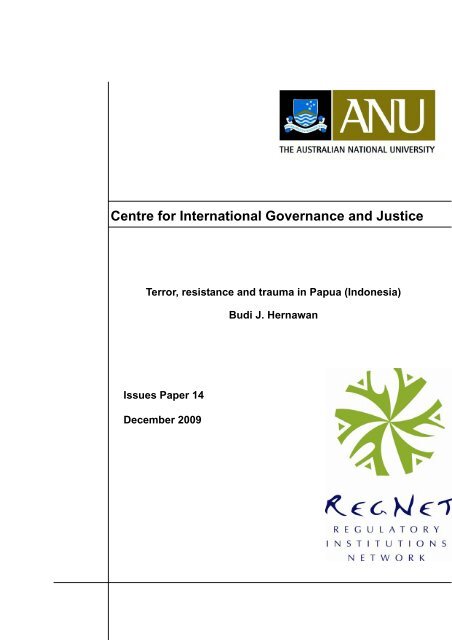
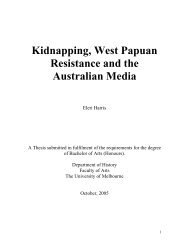
![[1958: Gahuku]. - PapuaWeb](https://img.yumpu.com/25139694/1/190x245/1958-gahuku-papuaweb.jpg?quality=85)
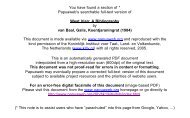


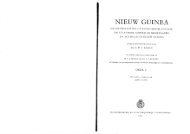
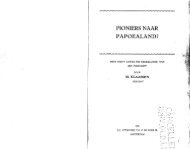
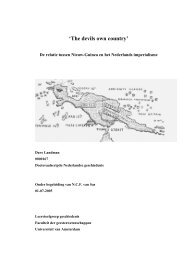
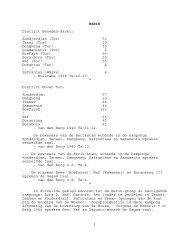
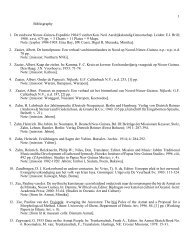

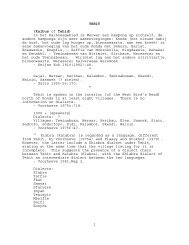
![1 EKARI (EKAGI) [Map] (cf S&C) Akaromani Apoejai ... - PapuaWeb](https://img.yumpu.com/19731685/1/190x245/1-ekari-ekagi-map-cf-sc-akaromani-apoejai-papuaweb.jpg?quality=85)
![WUTUNG [passim in text] Wutung (Oenaki, Oinåke) - Friederici ...](https://img.yumpu.com/15960045/1/190x245/wutung-passim-in-text-wutung-oenaki-oinake-friederici-.jpg?quality=85)